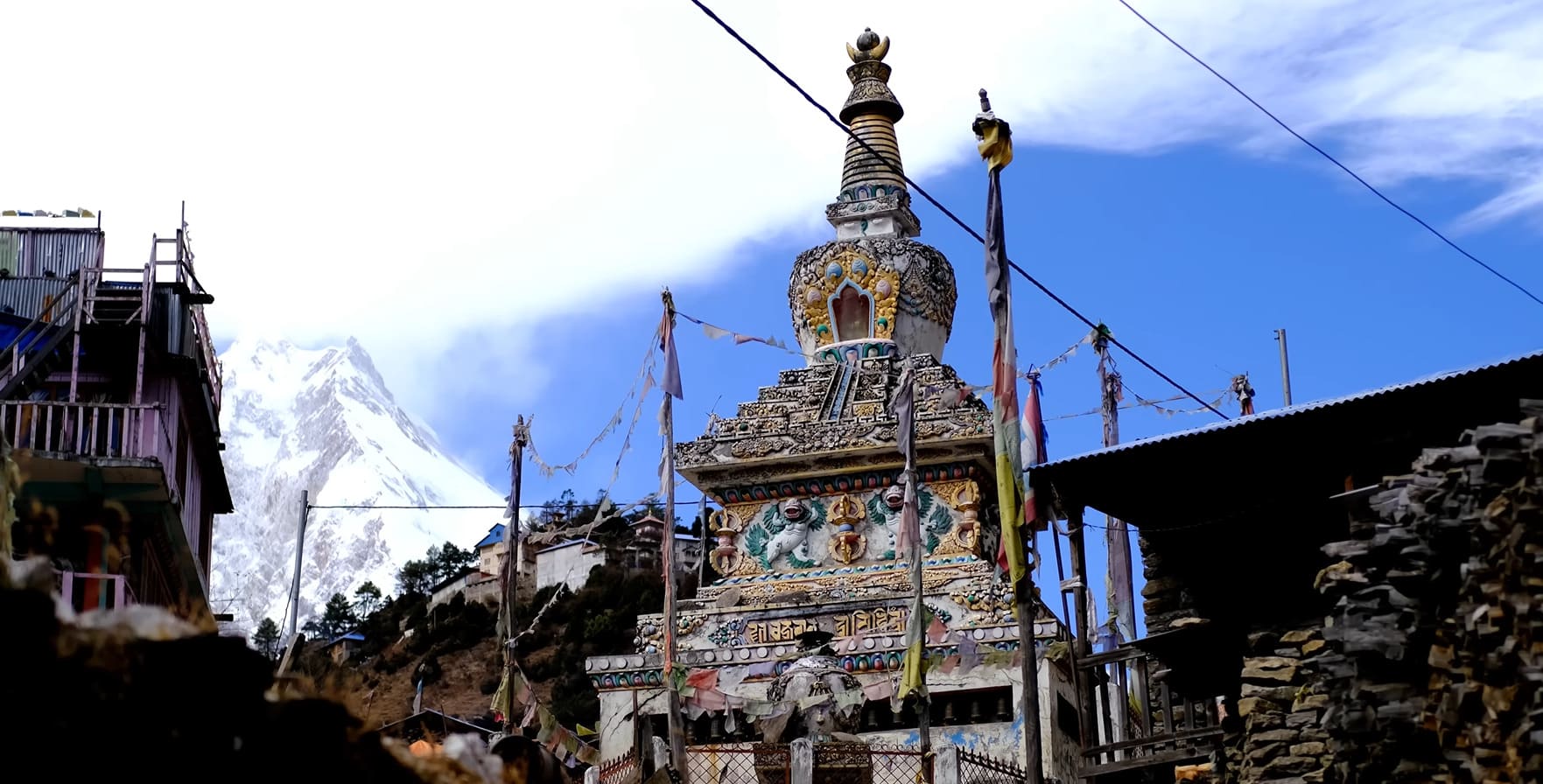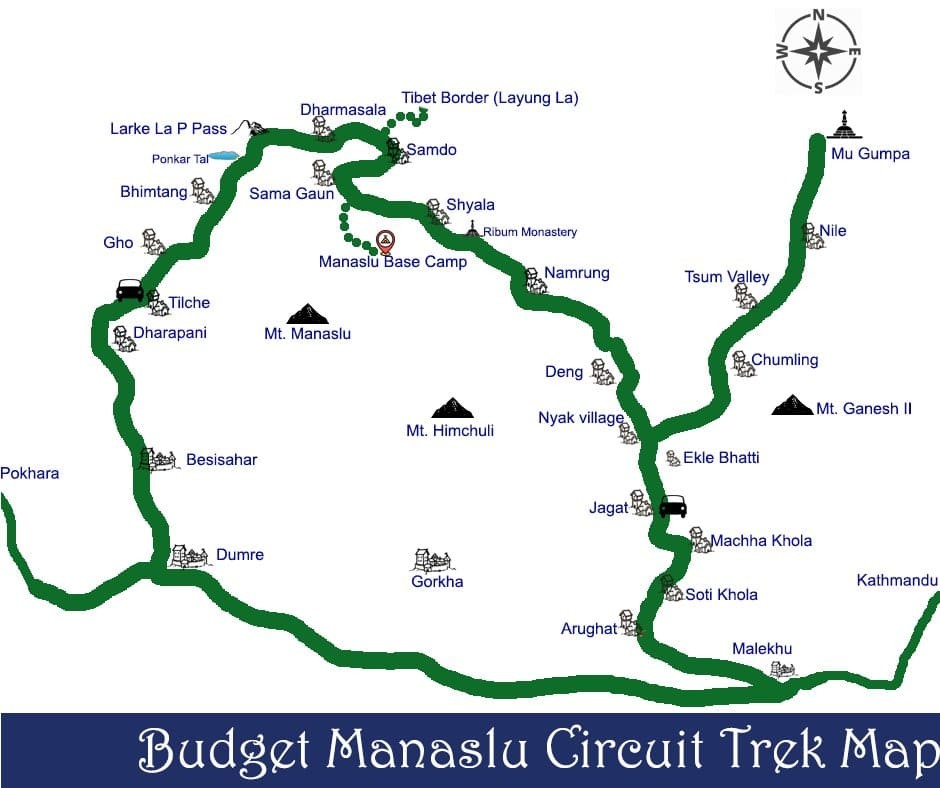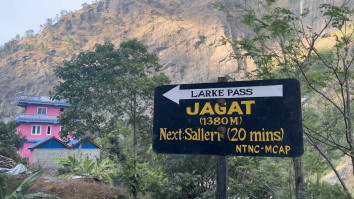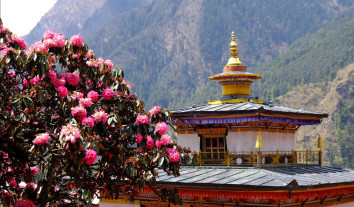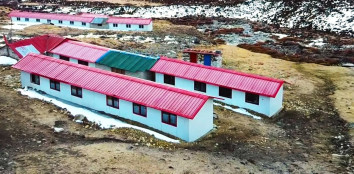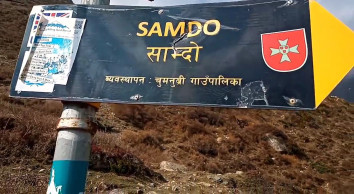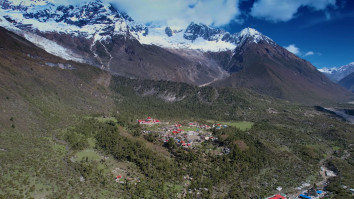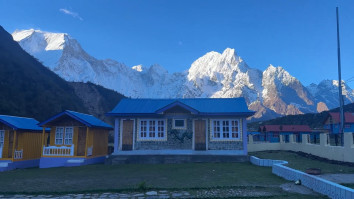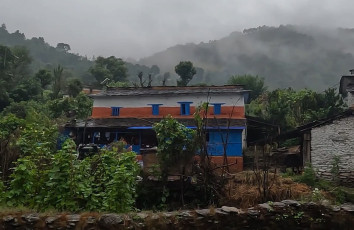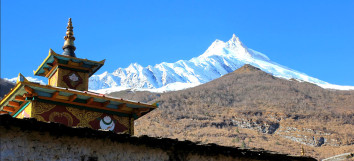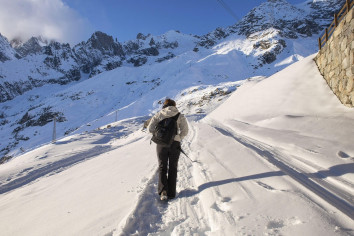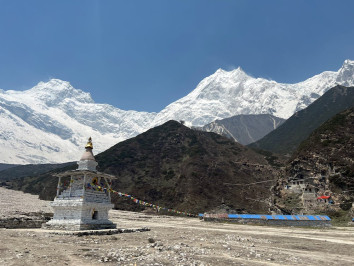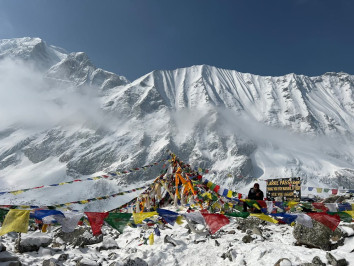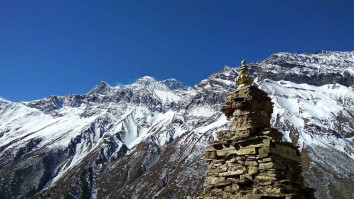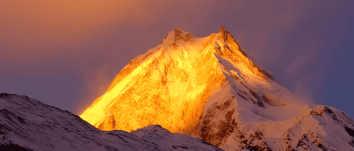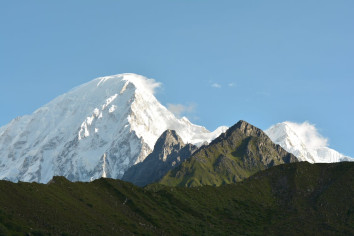Overview And Highlights
Budget Manaslu Circuit Trek is a adventurous and challenging but worth it trekking trail in Nepal as during the Manaslu Circuit Trek you will be reaching at the highest altitude of the 5130 meters above the level which is the Larke La Pass from were you can witness the beautiful mountain views of the Mount Manaslu (8,163m), Himalchuli (7,893m), Ganesh Himal range and in the distance you may witness the Annapurna II in the clear weather which is seen during the Annapurna base camp and the Annapurna circuit trek.
The Manaslu circuit trek lies inside the Restricted Area, due to which the region is highly protected by the Nepal government. The Nepal government has declared it a Restricted Area in order to protect the region’s unique cultural heritage, fragile ecosystem, and to ensure the safety and well-being of both trekkers and local communities. This area lies close to the Nepal-Tibet border, making it geopolitically sensitive, which calls for controlled access.
Manaslu Circuit Trek is also becoming famous now a days more than the Everest Base camp Trek and the Annapurna base camp trek as well for its less crowd, spectular views of the Mount Manaslu and its surrounding ranges, off-the-beaten-path, remote, authentic experience amid pristine natural beauty and traditional Tibetan-influenced villages, rich in cultural heritage, with ancient monasteries, local festivals, and welcoming communities that showcase Nepal’s diverse traditions. In short, the Manaslu circuit trek is becoming famous among trekkers for its combination of challenging terrain, breathtaking scenery, and cultural immersion, which is an adventure beyond the usual tourist routes.
Why should you do the Manaslu Circuit trek?
There are many reasons why you should do the Manaslu Circuit trek, as the Manaslu Circuit is not only a usual trekking trail but an unforgettable Himalayan adventure. The Manaslu circuit trek is famous for its breathtaking sunrises and sunsets over Mount Manaslu and the surrounding ranges, which is a once-in-a-lifetime moment to witness.
During the Manaslu trek, you will feel an authentic cultural experience as the region is highly influenced by the Tibetan communities who have preserved their culture and traditions, making it a perfect place for you to visit. You will witness the stone, mud, and wood houses, ancient monasteries, colorful prayer flags fluttering over the sky, the villages like Sama gaun, Deng, Jagat, and all the upper villages are covered with the majestic mountain in the backdrop, which gives you a genuine glimpse into the Himalayan life and the local people.
While trekking in the Manaslu circuit, you will see that there is a very limited number of trekkers on the trail, dense forests that cover the villages, terraced fields, and rugged mountain passes. Also, you will be crossing the Larkya La pass, which is at an altitude of 5130 meters, giving the feeling of solitude and wilderness during the trek.
About the Local Nubri Communities on the Manaslu Circuit
Nubri communities are among the most fascinating and culturally rich groups you will encounter on the Manaslu Circuit Trek. These indigenous Tibetan-Buddhist communities have lived in relative isolation for centuries, preserving their unique traditions, language, and lifestyle amid the stunning Himalayan landscape. For trekkers venturing through the Manaslu Circuit, engaging with the Nubri people offers a deeply authentic cultural experience that goes far beyond the breathtaking mountain views.
The Nubri people are primarily inhabitants of the Nubri Valley, which lies in the northern section of the Manaslu region near the border with Tibet (China). Their ancestry traces back to Tibetan settlers, and their culture reflects strong Tibetan Buddhist influences. The Nubri language is a dialect of Tibetan, and many community members also speak Nepali, though Tibetan remains the main language used at home and in religious ceremonies.
Nubri communities are deeply spiritual, with Tibetan Buddhism forming the core of their cultural identity. Their villages are dotted with colourful chortens (stupas), prayer flags fluttering in the mountain winds, and ancient monasteries where monks study and meditate. The rhythm of daily life revolves around religious festivals, agricultural seasons, and community gatherings. Nubri families practice subsistence farming, growing hardy crops suited to the high-altitude climate. Animal husbandry is equally important, with yaks, sheep, and goats providing milk, wool, and meat, as well as being essential for transportation and trade.
When trekking in the Manaslu circuit, you will witness the Nubri communities celebrating several Buddhist festivals with great fervor, such as Lhosar (Tibetan New Year), Buddha Jayanti (Buddha’s Birthday), and the Mani Rimdu Festival, a vibrant celebration featuring masked dances, music, and rituals performed by monks. These festivals provide a rare glimpse into the spiritual life of the Himalayas and are a highlight for you to be fortunate enough to coincide your journey with these festive events.
About Larkya La Pass, the highest point during the Manaslu Circuit
The Larke La Pass, which is the highest point during the Manaslu circuit trek at an altitude of 5130 meters above sea level, is one of the highest passes in the world. The Larkya La pass is one of the most dramatic highlights of the entire Manaslu circuit trek journey. When you will be crossing the Larkya la pass you will experience the demanding and deeply rewarding trek which will be offering the breathe taking Himalayan views of the Mansiri ranges and a true sense of adventure that few trekking routes in Nepal can match.
The ascent to Larkya La Pass typically begins from Dharamsala (also known as Larke Phedi), a basic high camp where trekkers spend the night before making the early morning push to the pass, which starts at 3 AM, gradually climbing over rocky moraines and icy ridgelines. Due to the altitude, you may feel the cold temperatures and thinner air, which may seem difficult even for experienced trekkers. But once you reach the destination, you will be rewarded with the true sense of the Himalayan adventure along with the beautiful sunrise over Mt. Manaslu (8,163m), Himalchuli (7,893m), Cheo Himal (6,820m), Kang Guru (6,981m), and Gyaji Kang (7,038m).
Why is the Manaslu Circuit a restricted area in Nepal?
The Manaslu Circuit is a restricted area in Nepal because of its border with Tibet (China), making it a geopolitically sensitive zone. Historically, this area has been used for cross-border trade, and even today, unauthorized movement across the border remains a concern. Also, the Manaslu region is home to indigenous communities like the Nubri and Tsum Valley people, who follow ancient Tibetan Buddhist traditions. These communities have lived in relative isolation for centuries, and the restricted status helps protect their intangible cultural heritage from the rapid impacts of mass tourism and modernization.
Also, the Manaslu Conservation Area is a biodiversity hotspot, home to rare and endangered species such as the snow leopard, red panda, Himalayan tahr, and a variety of alpine flora. Restricting access to the region allows authorities and conservation groups to monitor and minimize the environmental footprint of tourism. Due to the high altitude, rugged terrain, and remote location, the Manaslu Circuit can pose safety risks. The restricted status mandates that all foreign trekkers must trek with a licensed guide and be in a group of at least two people, which helps to enhance safety and ensure professional assistance in case of emergencies.
Manaslu Circuit trek Distance, Duration, and Altitude
Manaslu Circuit trek distance and durations depends on the places you are starting your trek and ending your trek. Also, your side trips play an important role in how much distance it would take you to cover the trek. See the table below to understand clearly.
Manaslu Circuit Trek Distance Overview
| Section |
Approx. Distance (km) |
| Soti Khola to Machha Khola |
15 km |
| Machha Khola to Jagat |
22 km |
| Jagat to Deng |
20 km |
| Deng to Namrung |
19 km |
| Namrung to Samagaon |
17 km |
| Samagaon to Samdo |
17 km |
| Samdo to Dharamsala (Larke Phedi) |
10 km |
| Dharamsala to Bimthang via Larkya La Pass |
24 km |
| Bimthang to Dharapani |
33 km |
| Total Approximate Distance |
177 km |
Manaslu Circuit Trek Durations
| Section |
Estimated Time (Days) |
Notes |
| Kathmandu to Soti Khola (Drive) |
1 day |
Long drive, often via Arughat |
| Soti Khola to Samagaon |
6–7 days |
Gradual ascent through villages and forests |
| Acclimatization at Samagaon |
1 day |
Side trip to Manaslu Base Camp or Pungyen Gompa optional |
| Samagaon to Dharamsala |
2 days |
Final approach to Larkya La |
| Cross Larkya La Pass to Bimthang |
1 day |
Long and challenging day (8–10 hours) |
| Bimthang to Dharapani |
2 days |
Descent into the Manang region |
| Dharapani to Kathmandu (Drive) |
1 day |
By jeep via Besisahar |
| Total Trek Duration |
14–18 days |
Varies by itinerary and rest/acclimatization days |
Manaslu Circuit Trek Altitude Profile
| Location |
Elevation (meters) |
Elevation (feet) |
| Soti Khola |
710 m |
2,329 ft |
| Machha Khola |
870 m |
2,854 ft |
| Jagat |
1,340 m |
4,396 ft |
| Deng |
1,860 m |
6,102 ft |
| Namrung |
2,630 m |
8,629 ft |
| Samagaon |
3,530 m |
11,581 ft |
| Samdo |
3,875 m |
12,713 ft |
| Dharamsala (Larke Phedi) |
4,460 m |
14,632 ft |
| Larkya La Pass |
5,106 m |
16,752 ft |
| Bimthang |
3,590 m |
11,778 ft |
| Dharapani |
1,963 m |
6,440 ft |
Manaslu Circuit trek difficulty and challenges
Manaslu circuit trek difficulty and challenges are the other things to consider during the trek, as you will be crossing one of the least crowded and least developed trekking trails along with one of the highest passes in the world. To complete your Manaslu circuit trek, you will need a previous trekking or at least hiking experience. While it doesn’t require technical climbing skills, the combination of high altitude, long trekking days, and remote terrain presents several physical and logistical challenges.
High Altitude sickness
The first and foremost risk of trekking in the Manaslu circuit is high-altitude sickness. During the whole trek, you will be trekking at a high altitude from 710 meters in Soti Khola and reach a maximum elevation of 5,106 meters at Larkya La Pass. The rapid altitude gain increases the risk of Acute Mountain Sickness (AMS). So in order to avoid the AMS, it's important for you to rest, acclimatize, and listen to your body. You can stop at the many beautiful villages where you can acclimatize and rest, like Samagaun, Samdo, Namrung, and many more. Ascend gradually and stay hydrated. Also, during the trek, know the symptoms of AMS, including headache, dizziness, nausea, and fatigue. In this case, inform your trekking guide immediately for a faster recovery.
Long Walking Days
As you will be trekking to one of the least known trekking destinations, the trails are not developed yet, making you walk for 6 to 8 hours per day, including the lunch break, tea breaks, and your walking pace. Some days, you might need to walk for 10 to 12 hours as well. For example, the day when you will cross the Larkya la pass, you will need to walk at least 12 hours from Dharamshala to crossing the Larkya pass to descending to the Bhimtang. The distance between Dharamshala and Bhimtang is 25 km, making it he longest walk of the Manaslu circuit trek.
Weather Variability and Cold Temperatures
Weather in the Manaslu region can be unpredictable. You may face scorching sun at lower elevations, sudden rain or snow showers, and freezing temperatures near the pass. Nights are cold even in the trekking season (September-November and March-May). Proper layered clothing and gear are essential to stay warm and dry. Read Related Blog: How to Prepare for High-Altitude Trekking: A Complete Guide
Manaslu Circuit trek cost 2025 and 2026
Manaslu circuit trek cost 2025/2026 depends on several factors, from the places you will stay during the trek and the city to the transportation, guides, food, and permits. The budget is around 800 USD to 1400 USD. As this package is for the budget Manaslu circuit trek, we will be talking about how to complete the Manaslu circuit trek on a budget.
Transportations
First and foremost, the place where you will be spending money is on transportation. As the Manaslu circuit trek starting point lies 200 km away from the Main Kathmandu city via Dhading Besi, to reach here on a budget, you will need to get pubic transportation like a public bus or a Public Jeep. The cost for the one-way trip to the Manaslu circuit trek starting point, which is Jagat, is NPR. 2000. So the round trip would cost you around NPRs. 4000 to Kathmandu.
Permits
The permits required for the Budegt Manaslu circuit trek or any other Manaslu region like the Larkya la pass trek, Tsum valley trek, Manaslu base camp trek every trekking destinations requires the same permits which is the Manaslu Conservation Area Permit (MCAP), Manaslu Restricted Area Permit (MRAP), Annapurna Conservation Area Project because you will be exiting via the Annapurna region in the Dharapani.
The cost for the ACAP is NPRs. 3000 fixed and in USD, the prices change for current as of 10/08/2025, it is 1 USD = 140, which is 21.42 USD. The cost for the Manaslu Restricted Area Permit includes all wards 1 to 4 of Chumnubri Rural Municipality, charges a trekking permit fee of USD 100 per person per week from September to November, with an additional USD 15 per day beyond one week. From December to August, the fee is USD 75 per person per week, with USD 10 per day for extra days beyond one week. The Manaslu Conservation Area Permit costs a fixed price at Nprs. 3000, which is 21.42 USD.
Foods
During the Manaslu Circuit Trek, food costs are generally affordable but can vary depending on the location and altitude. In lower villages, meals like dal bhat (rice and lentils), noodles, and simple vegetable dishes typically cost between USD 3 and 6 per meal. As you climb higher, prices increase due to transportation challenges, with meals ranging from USD 6 to 10 in more remote tea houses and lodges. Snacks, bottled water, and hot drinks like tea or coffee usually cost extra, around USD 1 to 3 each. It’s advisable to carry some high-energy snacks for long trekking days, as food options become limited and pricier at higher altitudes. Budgeting about USD 15 to 20 per day for meals is a reasonable estimate for the Manaslu Circuit Trek.
Accommodations
Accommodation costs on the Manaslu Circuit Trek vary by location and season but generally remain budget-friendly. In lower villages, basic tea houses and guesthouses typically charge between USD 5 and 10 per night for a simple room with shared facilities. As you ascend to higher-altitude villages, prices can rise to USD 10 to 15 per night due to limited resources and increased demand. During peak trekking season, some popular stops may be slightly more expensive. Most accommodations provide basic amenities such as a bed, blanket, and access to common areas, with hot showers usually available for an additional fee. Budgeting around USD 10 to 15 per night for lodging is a practical guideline for the Manaslu Circuit Trek.
Gear Rentals
For the Manaslu Circuit Trek, renting trekking gear can help reduce your overall costs if you don’t want to buy equipment upfront. Basic gear rentals such as sleeping bags, down jackets, trekking poles, and hiking boots typically cost between USD 5 and 15 per item per day, depending on the quality and rental shop. High-quality items like insulated jackets or sleeping bags may be on the higher end of this range. Renting gear in Kathmandu or Pokhara before starting the trek is common and convenient, with many shops offering packages or discounts for longer rental periods. Budgeting around USD 50 to 100 for essential gear rental for the entire trek is a good estimate if you plan to rent most of your equipment.
What is it like doing the Manaslu Circuit trek with Adventure Vision Treks?
Trekking the Budget Manaslu Circuit Trek with Adventure Vision Treks offers an unforgettable experience guided by expert local knowledge and personalized service by our guides and the owner, Jiban Thapaliya himself. Adventure Vision Treks ensures a well-organized journey, taking care of all permits, accommodations, and logistics, so you can focus fully on the stunning landscapes and cultural encounters along the trail. Our experienced guides provide valuable insights into the region’s history, culture, and natural beauty, while prioritizing your safety and comfort throughout the trek. With a strong commitment to responsible and sustainable tourism, Adventure Vision Treks also supports local communities, making your adventure not only memorable but meaningful. Trekking with us guarantees a smooth, enriching, and inspiring Manaslu Circuit experience.
Is the Budget Manaslu Circuit trek suitable for you?
Whether the Budget Manaslu circuit trek is suitable for you or not depends on several factors, such as understanding the Manaslu Circuit Trek, Physical Fitness & Trekking Experience, Altitude Considerations, Comfort Levels & Accommodation, Time Commitment, and Permits & Guide Requirements.
Understanding the Manaslu Circuit Trek
The Manaslu Circuit is a remote and less-known alternative to the Annapurna or Everest region treks. The Manaslu Circuit circles Mount Manaslu (8,163 m), the world’s eighth-highest peak, and crosses the dramatic Larkya La Pass (5,106 m). Along the way, you’ll trek through lush valleys, Buddhist villages, suspension bridges, and rugged alpine terrain. The trail offers a mix of moderate to strenuous sections, requiring a good balance of stamina, preparation, and determination.
Physical Fitness & Trekking Experience
The Manaslu circuit trek isn’t a casual stroll in the mountains. You’ll be walking 6–8 hours a day on varying terrain, sometimes uphill for hours at a stretch. Altitude also plays a big role, with several nights spent above 3,500 meters. While you don’t need to be a professional mountaineer, good cardiovascular fitness and previous multi-day trekking experience are highly recommended. If you’re used to regular hikes, gym workouts, or endurance sports, you’ll adapt well during the trek.
Altitude Considerations
Altitude Considerations are one of the most important factors to consider during the Manaslu circuit trek, as you will be trekking to the highest altitude of 5130 at the Larkya la pass, where the air is crisp and thin and the oxygen levels drop significantly. Altitude sickness can affect anyone, so proper acclimatization is crucial. The standard itinerary builds in gradual ascents to reduce risks, but you still need to be mindful of symptoms like headaches, nausea, or dizziness.
Comfort Levels & Accommodation
If you are a person who is in search of comfort levels and accommodations during the trek, then the Manaslu circuit trek might not be a good place for you, as during the Manaslu circuit trek, you will see the undeveloped trails if you compare them to Everest or Annapurna. You’ll be staying in basic tea houses, cozy but simple, with shared toilets, limited hot showers, and no central heating. Meals are wholesome but repetitive, mostly featuring dal bhat, noodles, potatoes, and soups. If you’re flexible and okay with fewer modern comforts, you’ll enjoy the authenticity.
Time Commitment
One of the main things to consider for the Manaslu circuit trek is the time commitment. As the trekking trail of the Manaslu region is not developed and the region is untouched by many, you will need a long day's trekking and at least 2 weeks to complete it. As the trek takes you to the highest altitude of 5130 meters, where there is not enough oxygen, you will need to acclimate your body starting from the starting point of the Manaslu circuit trek, which is Jagat or the Soti Khola. If you are okay with investing 2 weeks of your holidays, then the Budegt Manaslu circuit trek would be the best trek for you.
Permit & Guide Requirements
Another reasons which you should conider is the permtis and guides as the Manaslu circuit trek lies on the Tibet border and it is one of the most isolated trekking places in Nepal it is a restricted area which means you will have the limited number of palces to visit, and the guide would be compulsory or else there will be no entry.
How do you prepare for the Manaslu Circuit trek?
If you are now planning to do the Manaslu circuit trek, then you will need to know how to prepare for the trek so that during the trek, you don’t face any difficulties. You will need to understand the Manaslu circuit trek demand, Build Your Physical Fitness, be aware of the Acclimatization, pack the right gear, Secure Permits & Guide, Plan Your Budget, Pack Smart for Comfort, and make Mental preparations.
Understand the Manaslu circuit trek demand.
The Manaslu circuit trek is becoming famous among trekkers since 2022, after COVID, as trekkers wanted to avoid the populated trekking destinations like the EBC and ABC and find an alternate where they can enjoy the same culture, same vibes, but in less populated areas, and the Manaslu circuit trek came to the name. The trek is a mix of steep ascents, rocky paths, river crossings, and alpine trails.
Build Your Physical Fitness
Before heading towards the Manaslu trek, it's important for you to build your physical fitness, as during the trek, you will need your strength and stamina to complete the trek. A strong body will make your trek much more enjoyable. So start to prepare yourself before 2/3 months of the Manaslu circuit with the Cardio Training which includes hiking, running, cycling, or swimming to boost stamina, Strength Training which includes Focus on legs, core, and back with exercises like squats, lunges, and planks, Endurance Hikes which includes practicing walking with a loaded backpack on varied terrain.
Acclimatization Awareness
When you are on the trek, you will need to be aware of the acclimatization, as Altitude is one of the biggest challenges. The trek gradually takes you above 3,500 m, with the pass over 5,000 m, so to overcome this, you will need to follow a gradual ascent itinerary with acclimatization days. You will need to stay hydrated and avoid alcohol, and Learn to recognize symptoms of altitude sickness, such as headaches, nausea, or dizziness.
Get the Right Gear
To complete the Manaslu circuit trek properly without any difficulties, it is important for you to get the right gear for the trek. During the trek, you will be passing through lower valleys to highlands, so getting the gear according to requirement is important. You will need gear like Quality trekking boots (broken in before the trek), a Warm sleeping bag (rated to -15°C or lower), a Down jacket and base layers, Trekking poles, Rainproof jacket and pants, Gloves, hats, and thermal socks. You can get these items for yourself by buying or renting them in Kathmandu.
Secure Permits & Guide
As you will be trekking in one of the restricted areas in Nepal, you will need to get your permit, which is the ACAP, MCAP, and RAP, before heading towards your trekking destinations. The permits are available for you at the tourism board office and the trekking agencies like the Adventure Vision Treks, as the restricted area permit is issued by the trekking agencies only.
Plan Your Budget
It is very important for you to plan your budget before heading towards the Manaslu circuit trek. You will need to carry enough cash so that you don’t run out of cash and face difficulties during the trek, because during the trek, there are no facilities for paying with cards or ATMs. So you will need to prepare Meals (USD 15–20/day), Accommodation (USD 5–15/night), Gear rental or purchase, Snacks, Wi-Fi, charging fees, and hot showers.
Pack Smart for Comfort
If you are packing for the Manaslu circuit trek, it's important for you to pack smartly and comfortably so that you can have a smooth trekking experience. You will need to pack the essential packing lists like the trousers, trekking shoes, jackets, t-shirts, and everything you can check the list below. Except that you will need to bring the Reusable water bottle and purification tablets, Sunscreen and lip balm, Headlamp with spare batteries, High-energy snacks (nuts, chocolate, protein bars), Lightweight sandals for evenings, Small first-aid kit, and personal medications. The first aid kit will be provided by the trekking agencies as well.
Mental Preparation
When you are doing the Manaslu circuit trek, it's important for you to prepare mentally as well for things like simple meals and shared bathrooms, slow Wi-Fi, or no connectivity for days. Walking all day from morning to evening, meeting new people. Embrace the adventure and enjoy the slower pace of life.
Trekking in a group or solo for the Manaslu circuit?
When deciding between trekking solo or in a group for the Manaslu Circuit, it’s important to note that solo trekking is not permitted due to the region’s restricted status. All trekkers must be accompanied by a licensed guide and have at least one other paying trekker in the permit application. This means you’ll either need to join a group or arrange a trek with a partner. Group trekking offers a number of advantages, including division of guide and transport costs, extra safety in the wild, and the chance to interact with other travelers. On the other hand, small groups or exclusive bookings offer more flexibility of pace, timing, and rests while still satisfying permit requirements.
Whether you go with a large group or organize a small club, the experience will be richly rewarding because the Manaslu Circuit's natural beauty and cultural diversity are most enjoyed in good company and local expert guidance.
Charging, a hot shower, internet, and a toilet during the Manaslu Circuit trek
When you are trekking in the Manaslu circuit, it's important for you to know about the Charging, a hot shower, internet, and a toilet during the trek.
Charging during the Manaslu circuit trek
Electricity for charging devices on the Manaslu Circuit trek is available in most tea houses in the lower and upper regions, but it usually comes at an extra cost. Charging is often powered by solar panels or small generators, especially in higher villages, so the availability may be limited. Prices tend to rise as you ascend, so carrying a fully charged power bank or solar charger can be very helpful. You will need to pay around NPR. 500 to NPRs. 1000 per charge, depending on the tea houses and the altitudes.
Hot Shower
Hot showers are available in many tea houses, particularly in lower villages, and are typically heated by gas or solar power. However, as you go higher, the water may be only mildly warm, and the cost per shower increases. In colder altitudes, many trekkers opt to skip showers for a few days to avoid getting chilled.
Internet
Internet access is possible in several villages along the trail, like Jagat, Namrung, and Deng, usually through paid Wi-Fi or local mobile data. In lower altitudes, the connection is fairly reliable, but as you trek higher, the internet becomes slower, more expensive, and sometimes unavailable. Buying a local SIM card with a data plan before the trek can help you stay connected when possible.
Toilet
Toilet facilities vary depending on the altitude and the tea house. In lower areas, you’ll often find western-style toilets, but higher up, squat toilets are more common. These are usually shared among trekkers, and toilet paper is rarely provided, so carrying your supply and some hand sanitizer is highly recommended.
Bookings for Manaslu Circuit trek 2025/2026 departures!
Bookings are now officially open for the Manaslu Circuit Trek 2025/2026 departures, allowing adventurers to book their spot on one of the most scenic and culturally rich trekking routes in Nepal. With permits strictly controlled in this restricted region, early booking ensures you have ample time to prepare, choose your preferred dates, and trek with a well-planned group or private trek. Manaslu Circuit is renowned for its stunning Himalayan scenery, authentic village life, and thrilling experience of crossing the Larke La Pass (5,106m). Whether you want a sunny autumn trek or a spring trek through blooming rhododendron forests, early booking of your trek guarantees maximum logistics, guides, and lodging along the route. Don't miss the opportunity to join this unremembered high-altitude adventure in 2025 or 2026.
What to Expect from the Cost You Pay for the Manaslu Circuit Trek?
What to Expect from the Cost You Pay for the Manaslu Circuit Trek? It's the question that arises in every trekker's head when they are doing the Manaslu circuit trek, and it's genuine as well. As you are paying the money, you need to know what kinds of facilities you are getting.
Transportation
Your trekking cost typically includes all the necessary transportation from Kathmandu to the start of the trek and back, usually by private jeep or local bus. It takes a comfortable and convenient journey through picturesque countryside and into the far Gorkha district. As this package is for the Budget Manaslu trek, you will get the shared public bus.
Accommodations
Along the way, you will be provided accommodation in local tea houses or mountain lodges, each providing a clean bed, hot blankets, and a cozy atmosphere. Basic as they are, these lodges provide you with a firsthand experience of mountain hospitality and somewhere to put your tired head after a day's trek.
Trekking Guide
A certified and professional trekking guide is always by your side. They ensure you are safe, chart the route, offer cultural education, and take care of logistics so that you need not worry about anything and can enjoy the trek with utmost relaxation.
Trekking Accessories
Most of the packages also come with simple trekking gear such as a sleeping bag, trekking poles, or down jackets for rent. This saves you the hassle of purchasing equipment that you would probably use once.
All the necessary permits and documents
Manaslu Circuit is a restricted area, and special permits like the Manaslu Restricted Area Permit, Annapurna Conservation Area Permit (ACAP), and Manaslu Conservation Area Permit (MCAP) are required. Your trekking payment covers all these permits and documents, arranged by your operator.
All Standard Meals During the Trek
Your package generally includes three meals a day breakfast, lunch, and dinner served at tea houses along the trail. Expect a mix of Nepali, Tibetan, and basic continental dishes, providing the energy needed for high-altitude trekking. Meals are freshly prepared and tailored to the availability of ingredients in the region.
Accommodations on the Manaslu Circuit Trek
Accommodation on the Manaslu circuit trek offers rooms on a twin sharing basis with the basic BB facilities, which include breakfast and bed, along with shared rooms with mattresses, pillows, and blankets. The tea houses in Manaslu are relatively newer and simpler, reflecting the region’s pristine and less-touristed nature.
How are the rooms in tea houses during the Manaslu Trek?
The rooms in tea houses during the Manaslu trek are simple with no heaters or air conditioning, so a good quality sleeping bag rated for minus temperatures is essential, especially for nights at higher elevations. Extra blankets may be available, but they may not be available during peak season.
Facilities and Comfort in Manaslu Teahouses: Toilets, Showers, and Dining
Toilets
Most teahouses have squat-style Asian toilets, with western-style toilets mostly found in lower-altitude areas. Carry your toiletries as supplies can be limited.
Showers
Hot showers are available at some teahouses for a small additional fee (usually $2–3), mainly at lower elevations like Macha khola, Jagat, Deng, and mid-elevations like Namrung, Shyala, and Samagau. At higher altitudes like Samdo and Dharamshala, showers are rare or unavailable, and showering at these higher altitudes may attract you to hyperthermia or sickness, due to which most trekkers avoid taking showers at such higher altitudes.
Dining
Teahouses during the Manaslu circuit typically have spacious dining rooms with a fireplace, tables, and chairs. These communal spaces provide a warm and welcoming environment to meet fellow trekkers, share stories, and enjoy meals together.
Staying Connected and Powered Up: Internet and Electricity on the Manaslu Trek
Wi-Fi Availability
Wi-Fi service is offered at some teahouses at lower elevations but tends to be unreliable and often unavailable as you ascend. Connectivity drops significantly past places like Namrung or Sama Gaun.
Mobile Network
Buying a Nepali SIM card with a data package in Kathmandu is highly recommended for staying connected. Mobile network coverage is patchy but often better than Wi-Fi in remote areas.
Electricity and Charging
Most teahouses provide electricity for charging devices, but expect power outages and limited supply at higher altitudes. Some places rely on solar power. Carry a power bank as backup for your devices.
Popular Accommodation Spots Along the Manaslu Circuit Trek
Here’s a quick guide to key villages where you can find good teahouses and lodges:
Soti Khola: Basic guesthouses like Budi Gandaki and Satkar Guest House; decent food and services.
Machha Khola: More facilities, including hot showers and Wi-Fi (extra charges). Notable lodges include Everest Guest House and Hilltop Guest House.
Jagat: Comfortable stay with Wi-Fi. Popular are the Rubi Nala Guest House and the Manaslu Santi Guest House.
Deng: Restricted area, permit required; Wi-Fi available but no hot showers yet. Shangrila Cottage is a common choice.
Namrung: Improved facilities with hot water and Wi-Fi. Stay at Namrung Guest House or Nubri 4 Season Resort.
Lho: Good food, accommodation, and Wi-Fi at places like Manaslu View Guest House and Lama Guest House.
Sama Gaun: Final large village with hot showers and Wi-Fi. Options include Sama Gaun Guest House and Norling Guest House.
Samdo: Small village with basic teahouses such as Jambala Guest House.
Larkya Bazaar: Very limited facilities; no showers or Wi-Fi. Larkya Bazaar Guest House is the only option.
Dharamsala: Last stop before Larkya La Pass, minimal facilities, no showers or Wi-Fi.
Bimtang: Post-pass village with several quality teahouses offering hot showers and Wi-Fi.
Dharapani: Typical endpoint with guesthouses like Tashi Delek Lodge and Gorkha Inn.
Foods during the Manaslu Circuit
The foods during the Manaslu circuit are available, which are authentic Nepali dishes which is cooked over fire and wood, which gives the raw tastes of the Tibetan cultures and the Himalayan lifestyles. Also, your diet plays a vital role in keeping your energy levels up and helping you recover after long days on the trail. During the Manaslu circuit trek, you will get a variety of food options ranging from local Nepali dishes to some popular international meals.
Typical Food Options on the Manaslu Circuit Trek
There are 4 different types of Nepali food options during the Manaslu circuit trek, which are breakfast, lunch, dinner, and cold drinks and beverages.
Breakfast
As soon as you wake up, the first thing you do is to look for breakfast, and the breakfast in the Manaslu circuit is something special and according to your taste, which would give you energy and taste. There are various breakfast options for you, like:
Porridge
Porridge, which is warm, easy-to-digest oatmeal or corn porridge, is often served with sugar, honey, or milk. It is a light but nutritious option to start your day for the Manaslu trek.
Bread with Butter and Jam
Bread with Butter and Jam is another breakfast option that you can have at most of the tea houses. You will get Fresh or packaged bread slices, which will be served with local butter and fruit jam (apple, apricot, or strawberry). These breakfast options are loved by many trekkers as it is a quick and familiar choice for trekkers.
Eggs
For your breakfast, you can also have the eggs as an option, as you will be getting boiled, fried, or scrambled eggs, which will sometimes be served with toast or bread. Eggs are also A great source of protein to keep you energized for the day.
Tea and Coffee
Tea and Coffee are other drinks that can be eaten with any breakfast options provided above.
Instant Noodles (Optional)
If you don’t want to have the normal breakfast, then you can try the Instant noodles as well for breakfast. Instant noodles are Quick and easy if you prefer something familiar and filling.
These breakfast options are some of the options, but you also get lots of options for breakfast, which you can choose from the menu, and start your day.
Lunch
Lunch is usually eaten during a midday break on the trail or at a teahouse along the route. It’s important to have a filling meal to keep your energy levels high for the rest of the day’s trek. Here are common lunch choices for the trekkers, which fit the taste choices for the locals and the foreign trekkers as well:
Dal Bhat (Rice and Lentil Soup)
Dal Bhat (Rice and Lentil Soup) is the most famous dish in Nepal among Nepalese and trekkers as well. Dal bhat is eaten by Nepalese for lunch and dinner. The Dal bhat is served with steamed white rice, lentil soup (dal), which will be accompanied by vegetable curry (tarkari), pickles (achar), and sometimes meat curry (chicken, goat, or buffalo). It is highly nutritious and energy-packed.
Thukpa (Tibetan Noodle Soup)
Thukpa (Tibetan Noodle Soup) is the most famous and most loved dish by the Tibetan community. It is Warm noodle soup with vegetables and optional meat. It is Comforting and great for cold weather. The Thukpa is usually served with broth and vegetables like cabbage, carrots, and onions.
Fried Rice or Noodles
Fried Rice or Noodles is another option available mostly in all the tea houses during the Manaslu circuit trek. It is Stir-fried rice or noodles with vegetables and optional eggs or meat. The fried rice or noodles can be A quick and tasty alternative to dal bhat.
Momos (Steamed or Fried Dumplings)
Momos (Steamed or Fried Dumplings) is the most popular dish in Nepal and the most loved dish in Nepal after the Dal bhat. It is served in plates of 8 to 10 pieces. The dumplings are filled with vegetables, chicken, or buffalo meat. And it is often served with spicy dipping sauce.
Vegetable Curry with Bread (Roti)
Vegetable Curry with Bread (Roti) is another popular dish that is chosen by the trekkers for lunch. It is a Mixed vegetable curry served with local bread (roti or chapati). It is A vegetarian-friendly filling option.
These are the main items which is found during the trek. Along with these, you can find other food menu options as well, like Omelets and Eggs, Soups, and many more.
How to Find and Join a Manaslu Circuit Trek Group?
As you may know, solo trekking is not permitted in the Manaslu region. Trekkers are required to have a partner and a licensed guide to enter the Restricted Area. Therefore, solo trekkers must join a group. To facilitate this, Adventure Vision Treks offers joining groups, allowing trekkers to explore the Manaslu region safely and without any issues. We have fixed departures for the Manaslu Circuit Trek every day, providing an opportunity for you to join our group and fulfill your dream of experiencing this remarkable adventure.

